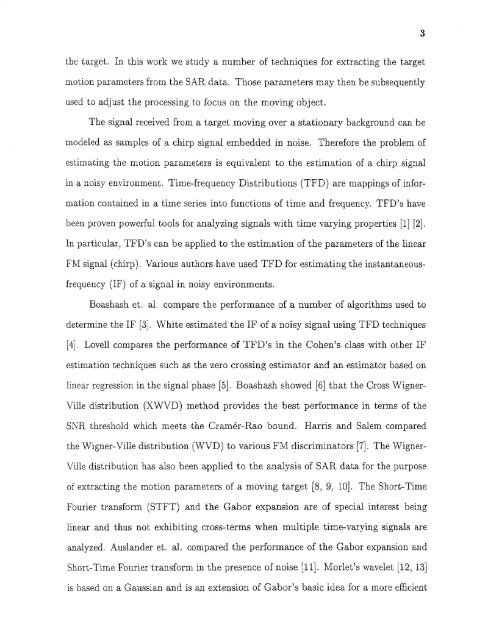Space/time/frequency methods in adaptive radar - New Jersey ...
Space/time/frequency methods in adaptive radar - New Jersey ...
Space/time/frequency methods in adaptive radar - New Jersey ...
Create successful ePaper yourself
Turn your PDF publications into a flip-book with our unique Google optimized e-Paper software.
3the target. In this work we study a number of techniques for extract<strong>in</strong>g the targetmotion parameters from the SAR data. Those parameters may then be subsequentlyused to adjust the process<strong>in</strong>g to focus on the mov<strong>in</strong>g object.The signal received from a target mov<strong>in</strong>g over a stationary background can bemodeled as samples of a chirp signal embedded <strong>in</strong> noise. Therefore the problem ofestimat<strong>in</strong>g the motion parameters is equivalent to the estimation of a chirp signal<strong>in</strong> a noisy environment. Time-<strong>frequency</strong> Distributions (TFD) are mapp<strong>in</strong>gs of <strong>in</strong>formationconta<strong>in</strong>ed <strong>in</strong> a <strong>time</strong> series <strong>in</strong>to functions of <strong>time</strong> and <strong>frequency</strong>. TFD's havebeen proven powerful tools for analyz<strong>in</strong>g signals with <strong>time</strong> vary<strong>in</strong>g properties [1] [2].In particular, TFD's can be applied to the estimation of the parameters of the l<strong>in</strong>earFM signal (chirp). Various authors have used TFD for estimat<strong>in</strong>g the <strong>in</strong>stantaneous<strong>frequency</strong>(IF) of a signal <strong>in</strong> noisy environments.Boashash et. al. compare the performance of a number of algorithms used todeterm<strong>in</strong>e the IF [3]. White estimated the IF of a noisy signal us<strong>in</strong>g TFD techniques[4]. Lovell compares the performance of TFD's <strong>in</strong> the Cohen's class with other IFestimation techniques such as the zero cross<strong>in</strong>g estimator and an estimator based onl<strong>in</strong>ear regression <strong>in</strong> the signal phase [5]. Boashash showed [6] that the Cross Wigner-Ville distribution (XWVD) method provides the best performance <strong>in</strong> terms of theSNR threshold which meets the Cramér-Rao bound. Harris and Salem comparedthe Wigner-Ville distribution (WVD) to various FM discrim<strong>in</strong>ators [7]. The Wigner-Ville distribution has also been applied to the analysis of SAR data for the purposeof extract<strong>in</strong>g the motion parameters of a mov<strong>in</strong>g target [8, 9, 10]. The Short-TimeFourier transform (SIFT) and the Gabor expansion are of special <strong>in</strong>terest be<strong>in</strong>gl<strong>in</strong>ear and thus not exhibit<strong>in</strong>g cross-terms when multiple <strong>time</strong>-vary<strong>in</strong>g signals areanalyzed. Auslander et. al. compared the performance of the Gabor expansion andShort-Time Fourier transform <strong>in</strong> the presence of noise [11]. Morlet's wavelet [12, 13]is based on a Gaussian and is an extension of Gabor's basic idea for a more efficient
















